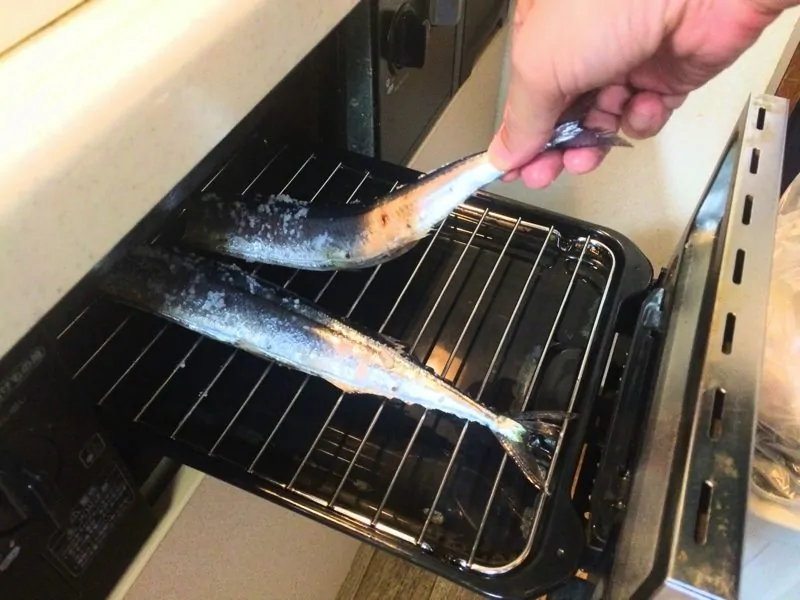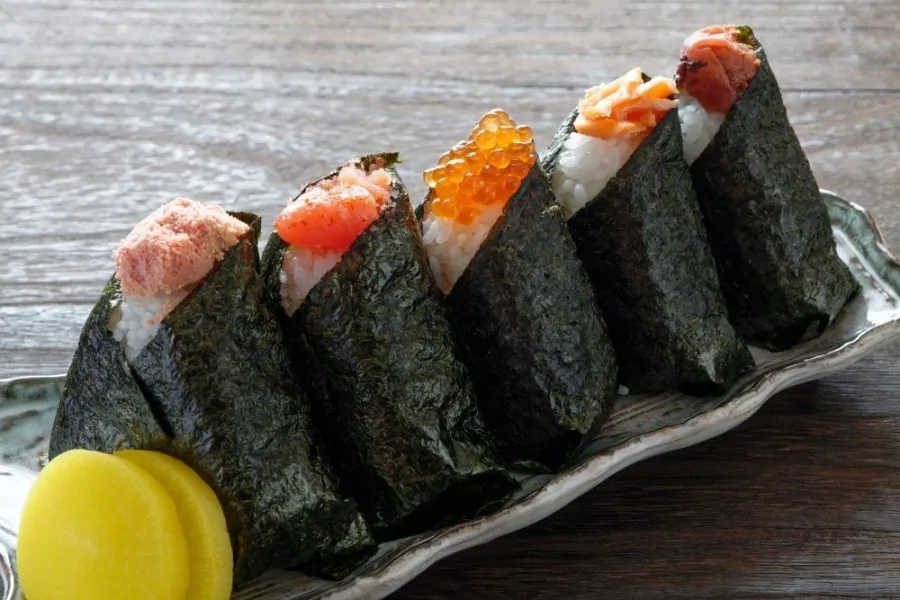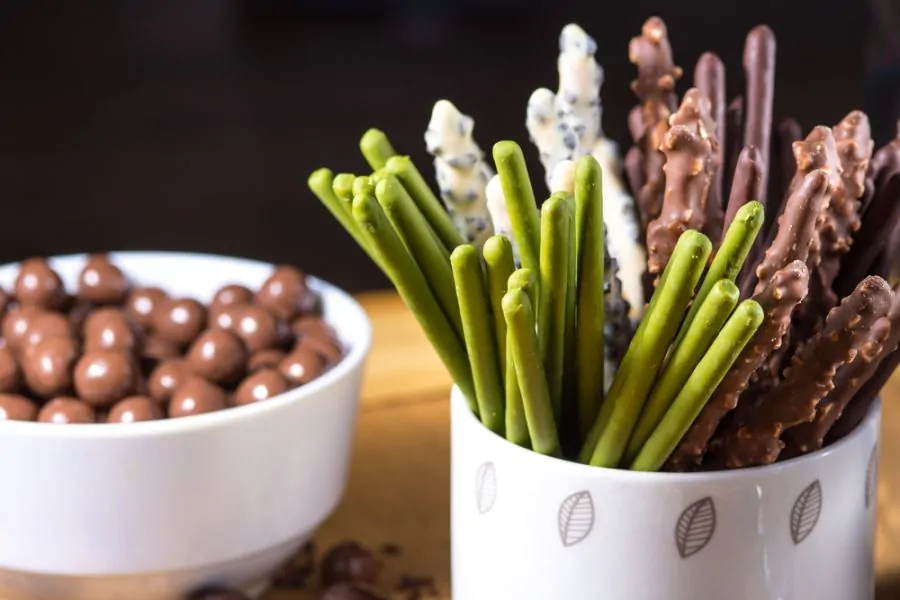If you’ve seen a Japanese kitchen, you might have noticed a small glass-fronted drawer underneath the oven unit’s gas range. This feature, which is absent from most Western ovens, is called a Japanese fish grill, and it’s a staple in most households in Japan.
This built-in fish grill is the perfect size to hold a couple of small fish, but you can use it to quickly cook all kinds of food.
Are you new to this efficient and convenient kitchen gadget and wondering how best to utilize it? Read on for a complete guide featuring all you need to know about the Japanese fish grill.
No products found.
What is a Japanese Fish Grill?
Most Japanese kitchens install the fish grill just below the stovetop. It is a metal drawer about the size of a shoebox containing a grill and at least one gas-powered heat source.
You’ll notice a glass window on the front of the unit to allow you to monitor your food while it cooks. The unit can reach a temperature of nearly 570 degrees Fahrenheit (300 degrees Celsius) in just a matter of minutes, making it a fast and convenient method of cooking many foods.
Since it has high heat capabilities and heats up faster than a conventional oven, the Japanese fish grill often takes the place of a traditional oven in many kitchens in Japan. This can be confusing and frustrating for visitors to Japan who are used to cooking in ovens.
However, once you’ve read this article and discovered all you need to know about the Japanese fish grill, you’ll soon find that it does everything you need. You won’t miss your oven once you get the hang of cooking on it.
Using Your Japanese Fish Grill
Cooking food on a Japanese fish grill is similar to other grills. The metal lattice holds the food, while gas burners on the top, top, and bottom of the unit heat up to cook the food. Depending on the type of food you’re preparing, you may wish to place a baking tray on top of the grill. Some fish grills require a layer of water in the bottom of the drawer to aid in cooking and to avoid fire when fish oil or olive oil drops onto the pan.
Step-by-Step Cooking Guide
- Turn on your grill by pressing the knob in for a few seconds until the gas ignites. (Note: check to see what type of grill you have and whether you need to fill the drawer with water first.) Turn the knob to the desired temperature for cooking and let your grill preheat for about five minutes.
- Watch your food through the glass window to avoid burning or overcooking.
- If your grill only has a top gas burner, turn your food over halfway through cooking to ensure it cooks evenly.
- Take out your cooked food as soon as you turn off the grill so your food won’t absorb the gas smell.
What Can I Cook on a Japanese Fish Grill?
Despite its name, you can use the Japanese fish grill for cooking more than just fish. Japanese people love using it for cooking chicken thighs or pizza, for instance.
The primary advantage of the Japanese fish grill over other cooking options is that its high heat cooks the outside of your food in a flash and makes it crispy while leaving the inside tender and juicy.
Pizza, vegetables, and even baked goods will be cooked to perfection in less time than in a conventional oven.
Here is a list of some everyday food items that are easy and delicious when cooked in a Japanese fish grill:
- Pizza
- Roast chicken
- Grilled vegetables
- Steamed vegetables wrapped in aluminum foil
- Toast
- Bread
- Puddings
- Pies
- Cakes
Japanese fish grill is a great way to reheat leftover fried or baked foods, such as French fries, crispy fried chicken, fried dumplings, and pizza. When you reheat these foods in a microwave, they often become soggy and unpalatable.
However, this grill uses high heat and short cooking time to eliminate this issue, keeping your fried and baked foods crisp and heating them to an appealing temperature for consumption. Note you can place aluminum foil, a tray, or an iron grill pan on the grid to make it more convenient to cook certain types of food.
How to Clean Your Japanese Fish Grill
Cleaning a Japanese fish grill is reasonably straightforward. If you’ve ever cleaned a backyard grill after a cookout or barbecue, you probably know how to clean this unit. Fortunately, Japanese fish roasters are much smaller than most outdoor grilling units, so they don’t require heavy-duty materials or solvents to stay clean.
To start with, you can avoid most messes by lining the bottom of your cooking drawer with aluminum foil to catch any stray drippings from meat or greasy food.
When it’s time for a deeper clean, simply add three parts of baking soda or potato starch to one part of water and apply the paste to your fish broiler. Let the paste sit for a few minutes before scrubbing gently with a damp cloth or sponge to remove corrosion and charred food.
Types of Japanese Fish Grills
Three main models of Japanese fish grill are typically found in Japanese kitchens. The primary difference between these types of grills is the number of gas burners and whether they require water to function.
A good rule of thumb is that less expensive fish grills require water and only have a burner on the top, while higher-quality, more costly grills will have a top and bottom burner and don’t need any water.
Top-Only Burner with a Water Drawer
The cheapest Japanese fish grills have a heat source over the top of the grill, not on the bottom. They also need to be filled with water before use.
These grills have an advantage in that they are the most cost-effective option. Additionally, the steam from the water keeps fish and other food from sticking to your grill, making your meals easier to extract when they’re done cooking fish.
A significant disadvantage to this grill is that you will need to flip your food during the cooking process to cook it evenly since there’s only one heat source over the top of the grill. Another downside to this grill type is that they’re more challenging to clean since you need to wait for the dirty water to cool and then empty it each time you use the unit. These grills also take longer to heat up and cook food than types with no water; therefore, they might not be suitable for cooking meat.
Top-Only Burner with No Water Drawer
This medium-priced option features a hybrid of the advantages and disadvantages of the cheaper and more expensive units you can buy. Like the previous grill type, this one only has one burner over the top, so it still takes longer to cook food, and you’ll need to turn most foods over in the middle of cooking. However, it doesn’t need to be filled with water before cooking, so clean-up is less complicated than you’ll find with a cheaper model.
If you want a model that’s easier to clean but isn’t too expensive, this type of grill could be a good compromise. It’s also a good choice for a “starter grill” if you’re interested in experimenting with these cooking units but don’t want to commit to the most pricey option right off the bat.
Top and Bottom Burners, No Water Drawer
This is the most expensive grill type you’ll find. It features a burner over the top of the food and underneath, and there’s no need to fill the tray with water before cooking your food.
This model has clear advantages over the top-only styles because it can cook your food half the time. There’s no need to disrupt your heat setting by opening the drawer to turn your food over. Additionally, the lack of water in the tray leads to a quicker and easier clean-up when you’re done cooking.
One slight drawback to this style is that food might be more likely to stick since there’s no steam to keep things loose. Additionally, if you’re new to using these grills, it can be easy to overcook your food on this model.
Finally, these are the most expensive Japanese fish grills on the market, so this style might not be the right choice if you’re on a budget.
The Japanese Fish Roaster: Your New Favorite Kitchen Gadget
Move over, toaster oven: there’s a new sheriff in town. The Japanese fish roaster is an excellent choice for your kitchen if you’re looking for a fast way to prepare all kinds of foods.
You can use it not just for grilling fish but also to prepare many of the same recipes that typically require a conventional oven or a microwave. You’ll be amazed at the simplicity and ease with which you can cook all your favorite foods in this convenient little unit.
Alternatively, if you find yourself staying in an apartment in Japan in the future, you’ll be fully prepared to make delicious meals in minutes.
Now that you’ve learned all you need to know about the Japanese fish grill, there’s no excuse not to get cooking!
Commonly Asked Questions about Japanese fish grills:
In Japan, kitchens include 2 or 3 gas burners with a small grill just below. Its dimensions are smaller than the typical oven found in American or European kitchens, and i’s called 魚焼きグリル.
Fish are cooked on salt and then cooked on the fire. Salt-grilling is the simplest way to cook fish on a grill. Japanese people usually eat this kind of cooked fish as a breakfast; this kind of cooking is called Shioyaki (塩焼き).
Shioyaki (塩焼き) means salt-grilled. The fish is first salted and left to chill overnight, then grilled, usually in the morning. Shioyaki is typically eaten with soy sauce as breakfast in Japan.





Where to buy one?